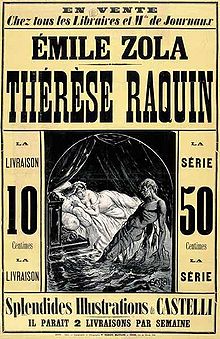9月29日今昔反思 Portrait d'Émile Zola 左拉:《苔蕾斯·拉甘》、 La Terre. 等。《寫實主義》Realism by Linda Nochlin 中的《工人英雄萬歲》.....
9月29日
左拉(Émile Zola)
(西元1840.4.2—1902.9.29)
法國作家。自然主義文學的代表人物。具有社會主義的傾向,曾在迫害猶太籍軍官德萊弗斯的冤獄案件中,公開發表言詞激烈的點名指控信。重要著作包括《娜娜》、《萌芽》與《盧貢‧瑪卡爾家族》等。
青年呀、青年呀,你們必須永遠與正義站在一起!假如正義的觀念,逐漸從你的心裡淡去,你將陷入危險的境地。……你為何沒有懷抱著充滿俠義心的美夢,試想著假若在某個角落,有某位殉教者即將屈服於憎惡的膝下,你必將前去為他辯護營救呢?……然而今日,原本該由你對倒施逆行感到義憤填膺,並且滿懷狂熱地投入奮鬥,卻由你的長輩老人們代替你邁向這項志業,你難道不覺得羞愧嗎?
~~節自《真理在向前邁進》
For the film adaptation, see The Earth (1921 film).
La Terre (The Earth) is a novel by Émile Zola, published in 1887. It is the fifteenth novel in Zola's Rougon-Macquart series. The action takes place in a rural community in the Beauce, an area in central France west of Paris. The novel is connected to others in the series by the protagonist, Jean Macquart, whose childhood in the south of France was recounted in La Fortune des Rougon, and who goes on to feature prominently in the later novel La Débâcle.
 The Earth (1887). | |
| Author | Émile Zola |
|---|---|
| Country | France |
| Language | French |
| Series | Les Rougon-Macquart |
| Genre | Naturalist novel |
| Publisher | Charpentier |
Publication date | 1887 |
| Media type | Print (Serial, Hardback & Paperback) |
| Preceded by | L'Œuvre |
| Followed by | Le Rêve |
-----
Portrait of Émile Zola is a painting of Émile Zola by Édouard Manet. Manet submitted the portrait to the 1868 Salon.
At this time Zola was known for his art criticism, and perhaps particularly as the writer of the novel Thérèse Raquin. This told the story of an adulterous affair between Thérèse, the wife of a clerk in a railway company, and a would-be painter named Laurent, whose work, rather like that of Zola's friend Paul Cézanne, is denigrated by the critics.[1] In the eleventh chapter the milieu of Manet's Le Déjeuner sur l’herbe is evoked, in the murder scene, where Camille, the husband, goes out for the day with his wife and her lover to Saint-Ouen.
On the wall is a reproduction of Manet's Olympia, a controversial painting at the 1865 Salon but which Zola considered Manet's best work. "Behind it is an engraving from Velazquez's Bacchus indicating the taste for Spanish art shared by the painter and the writer. A Japanese print of a wrestler by Utagawa Kuniaki II completes the décor." A Japanese screen on the left of the picture recalls the role that the Far East played in revolutionizing ideas on perspective and colour in European painting.[2]
References[edit]
- ^ Ross King, The Judgment of Paris, p. 223.
- ^ "Musée d'Orsay: Edouard Manet Emile Zola". www.musee-orsay.fr. Retrieved 2019-08-29.
『エミール・ゾラの肖像』(Portrait d'Émile Zola)は、エドゥアール・マネが1868年に完成した油絵。エドゥアール・マネの友人で小説家のエミール・ゾラの肖像を描いたものである。1868年のサロン・ド・パリに出品された。パリのオルセー美術館所蔵である。
背景の浮世絵は大鳴門灘右エ門 (初代)の相撲絵である。作者は歌川国明 (2代目)(一説には初代歌川国明)と見られている。
Portrait d'Émile Zola
| Artiste | Édouard Manet |
|---|---|
| Date | 1868 |
| Type | huile sur toile |
| Dimensions (H × L) | 165 × 114 cm |
| Collection | |
| N° d’inventaire | RF 2205 |
| Localisation | Musée d'Orsay, Paris (France) |
Le Portrait d'Émile Zola est un tableau réalisé en 1868 par le peintre Édouard Manet, désireux de manifester sa reconnaissance à Émile Zola pour le soutien actif qu'il manifestait alors à son art.
La toile, acceptée au Salon de Paris de la même année, contient plusieurs éléments anecdotiques et discrets révélant l'amitié des deux hommes : outre la reproduction d'Olympia accrochée au mur, et dans laquelle le regard de Victorine Meurent a d'ailleurs été légèrement modifié par rapport à l’original afin de fixer Zola, on distingue sur le bureau le livre bleu-ciel que l’écrivain avait rédigé pour défendre Manet. L'entente entre les deux hommes, toutefois, ne dura pas : de plus en plus perplexe face à l’évolution impressionniste que connaissait le style de Manet, bien loin du réalisme qu’il prisait, Zola finit par rompre tout contact.
Sur le mur du fond, la reproduction de l'Olympia est associée à d'autres de Goya d'après Vélazquez (Le Triomphe de Bacchus) et d'Utagawa Kuniaki II. Le choix de ces reproductions est significatif des influences esthétiques de Manet. Le tableau, peint par de larges aplats, fortement contrasté, la gamme de couleur ocre, évoquent davantage la tradition picturale allant de Velasquez à Goya que les maîtres italiens.
Liens externes[modifier | modifier le code]
- Ressources relatives aux beaux-arts :
- Joconde
- Musée d'Orsay
- Salons 1673-1914
Emile Zola, Thérèse Raquin《苔蕾斯·拉甘》1867 / 1873"Thérèse Raquin" is Emile Zola's novel that revolves around adultery and murder. This novel tells the story of a young woman who was unhappily married to her first cousin living with her overbearing aunt.Zola describes this piece as the "study temperaments and not characters." Because of this novel, the author was considered as an example of naturalism.His novel was later adapted as a play in 1873, which he also wrote. The story has since been made into films, mini-series, musicals, and more."They turned me into a hypocrite and a liar. They stifled me with their bourgeois comfort and I don't understand why there is any red blood left in my veins. I would lower my eyes and put on a sad, imbecilic face like them, leading the same dead life. [...] they had turned me into a docile creature with their weak kindness and their repulsive tenderness. So I lied, and I kept on lying. I stayed there, sweet and silent, dreaming about how I could hit and bite." - Emile Zola, 'Therese Raquin'Thérèse Raquin 
Written by Émile Zola Date premiered 1867 / 1873 Original language French Genre Naturalism, theatrical naturalism, psychological novel 左拉與自然主義思潮
自然主義的誕生
1857年,哲學家泰納在《批評和歷史論文集》中首先為文學上的自然主義下了定義,即以來觀察,用科學方法描寫生活。左拉接受了泰納的美學理論。他還閱讀了法國醫生呂卡斯的《自然遺傳的哲學和生理學論著》、勒圖爾諾醫生的《情慾生理學》、達爾文的《物種起源》等生物、遺傳學著作,逐漸形成了一整套自然主義的文學主張。


沒有留言:
張貼留言